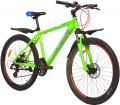Speeds
The number of speeds (gears) provided for in the design of the bicycle. Each transfer has its own so-called gear ratio — in this case it can be described as the number of revolutions that the driven gear (rear, on the wheel) makes in one revolution of the leading gear (associated with the pedals).
Different gear ratios will be optimal for different conditions: for example, high gears provide good speed, but are poorly suited for overcoming obstacles, because. the effort on the pedals increases significantly and the frequency of their rotation decreases. It has been scientifically proven that a cyclist develops maximum power at a cadence of about 80-100 rpm. Thus, the presence in the bike of several speeds allows you to optimally adjust it to different driving modes and features of the tracks in order to provide optimal pedaling force and frequency of their rotation. For example, on smooth asphalt it is best to drive in a high gear, and when overcoming a rise or entering a dirt road, you can lower it in order to effectively overcome resistance.
The number of gears in classic systems is directly related to the number of stars of the system (on the bottom bracket with pedals) and the cassette (on the rear wheel); it can be obtained by multiplying two numbers — for example, 3 stars of the system and 6 on the cassette give 18 gears. However, there is also the so-called planetary hubs — there are stars one at a time, and gear shifting is carried out by a mec...hanism built into the rear hub.
Note that the optimal number of gears depends on the purpose of the bike (see above), and it is not always necessary to have several of them. So, in mountain models, depending on specialization, there can be from 8 to 30 gears, in road ones — within 20-30, and some inexpensive city bikes and most BMXs do not have a gear shift system at all.
Freewheel cogs
The number of stars (gears) of different sizes in a bicycle cassette. A cassette is a part of the rear hub that interacts directly with the chain, in other words, a gear or a set of gears mounted on the hub. In classical gear shifting systems, the number of gears directly depends on the number of stars in the cassette (for more details, see "Speeds"); a single chainring is used either in single speed bikes or in planetary hubs (see System Stars for more on these).
Rear derailleur
Model of the derailleur (derailer) installed on the rear wheel cassette as standard on the bike. For more information on why you need to know the model of a particular bicycle component, see paragraph "Cassette Model".

